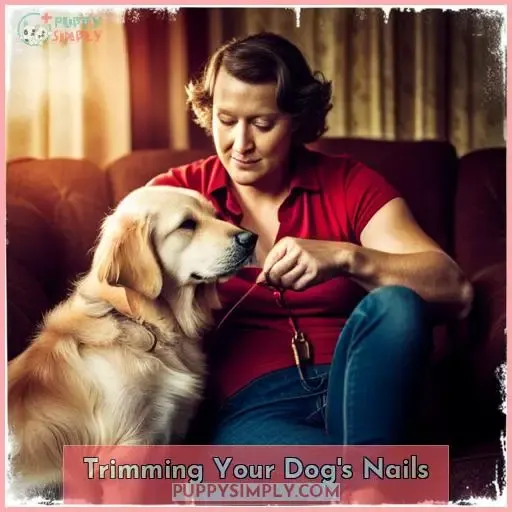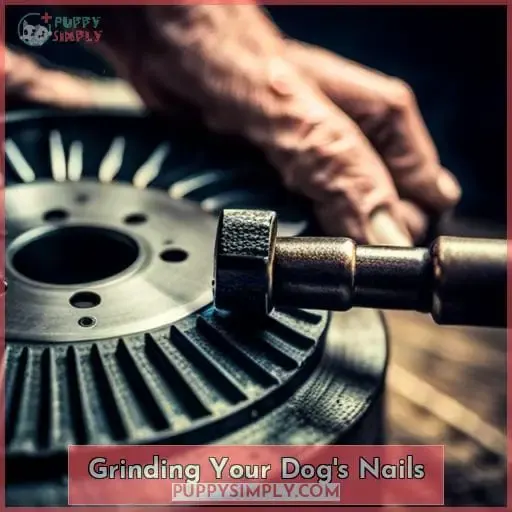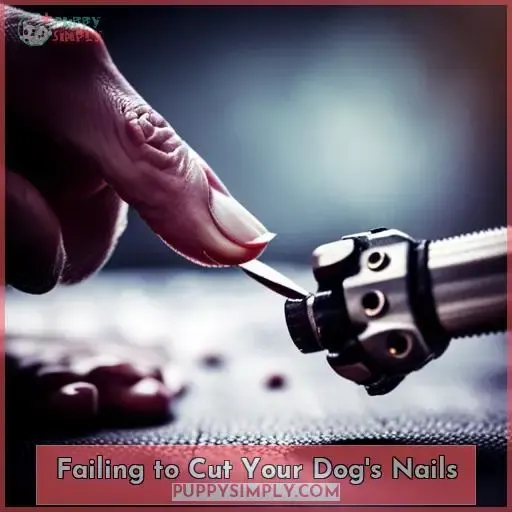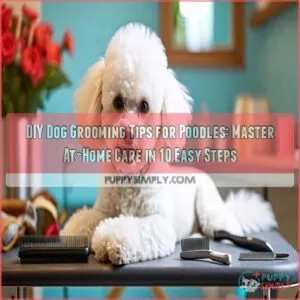This site is supported by our readers. We may earn a commission, at no cost to you, if you purchase through links.
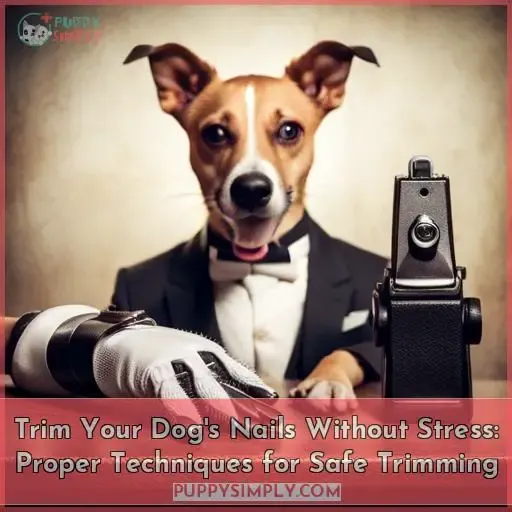 You’ve likely put off clipping your dog’s nails simply because it makes you uneasy. But letting those nails grow too long negatively impacts their health. It’s time to face those clippers and learn proper techniques to trim your dog’s nails without stress.
You’ve likely put off clipping your dog’s nails simply because it makes you uneasy. But letting those nails grow too long negatively impacts their health. It’s time to face those clippers and learn proper techniques to trim your dog’s nails without stress.
With some planning and positive reinforcement, you can master a skill that keeps your best friend comfortable.
Table Of Contents
- Key Takeaways
- Getting Your Dog Comfortable
- Trimming Your Dog’s Nails
- Grinding Your Dog’s Nails
- Failing to Cut Your Dog’s Nails
- Preventive Measures for Stress-Free Nail Trimming
- Dealing With Cut Quicks
- Frequently Asked Questions (FAQs)
- What are the different types of nail clippers and grinders?
- How do I know if I’m cutting my dog’s nails too short?
- What should I do if I cut my dog’s nail too short and it starts bleeding?
- How often should I trim my dog’s nails?
- What are some tips for making nail trimming a more positive experience for my dog?
- Conclusion
Key Takeaways
- Introduce the nail clipper or grinder gradually and use positive reinforcement.
- Be patient, keep sessions brief, and end on a positive note.
- Choose the right nail trimmer and practice safety precautions.
- Trim nails regularly to maintain short nails and prevent discomfort or injury.
Getting Your Dog Comfortable
When introducing your dog to nail trimming, go slowly.
Allow your dog to become familiar with the nail clippers or grinder by letting them sniff and lick the tool, rewarding them with treats and praise.
Over the course of a week, work your way up to briefly touching their paws and nails with the tool before attempting any actual trimming.
Introducing the Nail Clipper or Grinder
You’ll want to introduce the nail clipper or grinder to your dog gradually over the course of about a week.
- Allow your puppy to sniff the tool while providing treats and praise as positive reinforcement.
- Progress to light touches on each paw with the tool while continuing positive reinforcement.
- Familiarize your puppy with the sound and vibration of the tool without actually trimming.
- Gradually increase the trimming process, starting with one nail and advancing each day while ensuring your puppy remains comfortable.
Using Positive Reinforcement
With positive reinforcement, you’ll want to reward your dog with treats and praise during and after introductions to the nail clipper or grinder.
As you familiarize your dog with these tools, use reward-based techniques to boost canine confidence, reduce stress, and set the stage for future stress-free grooming.
Be patient and keep sessions brief, ending on a positive note with a calming bath or relaxing playtime after nail trims.
Gradual Progression
Start by gradually introducing your dog to the nail clipper or grinder.
Use training techniques that promote positive reinforcement and puppy adaptation.
Allow your furry friend to become familiar with the tools through sniffing, treats, and praise.
Take small steps each day, such as light touches on their paws or letting them hear the sound of the tool without actually trimming.
This gradual progression will help alleviate any trimming challenges and ensure a stress-free grooming experience for both you and your pet.
Trimming Your Dog’s Nails
Now that you have familiarized yourself with the importance of trimming your dog’s nails and how to get them comfortable, let’s discuss the actual process of trimming.
Choosing the right nail trimmer is crucial for a safe and effective trim. Whether you opt for scissors or grinders, it’s important to use proper technique when clipping your dog’s nails.
Additionally, don’t forget about those dew claws – they require special attention during the trimming process as well.
Choosing the Right Nail Trimmer
To ensure a safe and stress-free nail trimming experience for your dog, it’s important to choose the right nail trimmer.
There are two main types of nail trimmers: electric and manual.
Electric trimmers are powered tools that grind down the nails, while manual trimmers come in various styles such as guillotine-style clippers or scissors.
Consider factors like your dog’s size, comfort level with noise and vibration, as well as personal preferences when selecting a nail trimmer.
Safety precautions should also be taken into account to prevent accidents during the trimming process.
Proper Nail Clipping Technique
Now, let’s delve into the proper technique for trimming your dog’s nails.
You’ll want to follow these steps regularly to ensure your furry friend stays comfortable and their nails stay at a healthy length.
- Firmly hold each toe while clipping just the tip of each nail at a 45-degree angle to avoid hitting the quick and causing bleeding.
- Cut frequently enough to maintain short nails and schedule trims to minimize stress.
Clipping Dew Claws
You’ll want to use the scissors-type trimmer when clipping your dog’s dew claws, applying similar cutting techniques as you do for the other claws but exercising additional caution given their unique positioning and anatomy.
Ensure proper visibility when handling dark dew claws, being prepared to stop bleeding if accidentally cutting too short.
Special clipping techniques help avoid dew claw dangers like cracking or tearing.
Grinding Your Dog’s Nails
To grind your dog’s nails, you’ll need a safe grinding tool that can gradually remove small parts of the nail at a time.
When grinding, it’s important to support your dog’s toe firmly but gently to ensure stability and prevent any discomfort.
The technique involves grinding across the bottom of the nail and carefully smoothing rough edges from the tip.
Using a Safe Grinding Tool
When it comes to grinding your dog’s nails, it’s important to use a safe grinding tool that will ensure a stress-free and comfortable experience for both you and your furry friend.
Select a high-quality electric grinder designed specifically for pets to avoid injury.
Gently secure the paw during grinding and work in short sessions to minimize stress.
Apply light pressure across the nail tip using smooth back-and-forth motions.
Providing treats and praise will make it a more positive experience.
Supporting the Dog’s Toe
While using the grinding tool, you’ll want to support the dog’s toe firmly but gently to keep it steady during the process.
- Grip the paw above the toe pads
- Ensure your hold is secure but not too tight
- Keep hair and skin clear of the grinding wheel
- Check that the toe is properly extended
- Monitor the dog for signs of discomfort
Grinding Technique
Proper Techniques for Safe Trimming:
The implementation of proper technique lets you grind small sections across the bottom and carefully from the nail tip, smoothing any rough edges while avoiding catching hair.
With a firm yet gentle hold on the paw, use precision grinding in short bursts, carefully monitoring nail length and proximity to the quick as you smooth edges.
Gradually build your dog’s comfort with the sensation and sound.
Failing to Cut Your Dog’s Nails
Neglecting to trim your dog’s nails can have serious consequences for their health and well-being.
Long nails can cause discomfort, pain, and even injuries such as splayed feet or reduced traction.
Regular nail maintenance is crucial in promoting the receding of the quick and ensuring your dog’s comfort.
Importance of Regular Nail Maintenance
Neglecting your dog’s nail maintenance can have significant consequences for their well-being and comfort.
Regular trimming is crucial for preventing pain and discomfort in your furry friend.
Long nails may lead to joint pressure, impacting paw health.
Stress-free trims are essential for maintaining comfortable paws.
Ensure your dog’s safety and well-being by incorporating regular nail maintenance into your pet care routine.
- Regular trimming prevents joint pressure.
- Long nails impact paw health.
- Ensure comfortable paws with stress-free trims.
- Prioritize your dog’s well-being and safety.
- Incorporate regular nail maintenance for optimal comfort.
Consequences of Long Nails
If you neglect regular nail maintenance for your dog, the consequences of long nails can be detrimental to their health and well-being.
Long nails can cause joint discomfort, as they put pressure on the paw pads and joints when walking or running.
Additionally, long nails can lead to toe twisting, which can be painful for your dog.
It’s important to regularly trim your dog’s nails to prevent these issues and ensure their comfort during outdoor activities while minimizing professional stress during nail trims.
Natural Nail Wear
As your dog’s nails naturally wear down, it plays a crucial role in maintaining their paw health and comfort.
Outdoor activities contribute to this process, providing exercise benefits and promoting canine hygiene.
The terrain impact from varied surfaces helps naturally trim nails, preventing splayed feet and ensuring your dog’s well-being.
Regular monitoring of your active companion’s paws supports their natural nail wear for optimal foot health.
Preventive Measures for Stress-Free Nail Trimming
To ensure a stress-free nail trimming experience for your dog, it’s important to introduce the process gradually.
Start by familiarizing your dog with the tools and rewarding them with positive reinforcement during and after each session.
By taking these preventive measures, you can help your dog become more comfortable with nail trimming and reduce their stress levels.
Introducing Nail Trimming Gradually
Start your dog’s journey to stress-free nail trimming by introducing the nail clipper or grinder gradually over a week.
Build confidence through positive associations—allow your pup to sniff the tool, rewarding with treats.
With gradual exposure and patience, progress to light touches on each paw.
Create a calm environment to foster comfort, paving the way for successful and stress-free nail trimming sessions.
Positive Reinforcement
Enhancing your dog’s comfort during nail trimming involves incorporating positive reinforcement, fostering a sense of security and trust that paves the way for stress-free grooming experiences.
Reward techniques, such as treats, praise, and play, can help your dog associate nail trimming with positive experiences and encourage future cooperation.
Familiarizing the Dog With Tools
In addition to positive reinforcement, you can also familiarize your dog with the tools you’ll use for nail trimming.
- Let your dog sniff the tool, offer treats, and use positive reinforcement.
- Keep the tool away from your dog when not in use, and play with it occasionally to keep your dog comfortable with it.
Dealing With Cut Quicks
If you cut your dog’s nail too short, the quick may bleed. Don’t panic, this is a common occurrence.
Styptic powder can stop the bleeding.
Other alternatives to styptic powder include cornstarch, baking powder, flour, or baby powder.
Bleeding From Cut Quicks
If you accidentally cut your dog’s nail quick, bleeding can occur.
- Styptic powder can stop the bleeding.
- Cornstarch, baking powder, flour, or baby powder can also be used.
- The bleeding should stop within a few minutes.
Styptic Powder for Stopping Bleeding
When dealing with cut quicks, it’s important to have styptic powder on hand in case of bleeding.
Styptic powder helps stop bleeding quickly and efficiently.
To use, simply apply a small amount of the powder directly onto the nail where the cut occurred.
The styptic powder works by constricting blood vessels and promoting clotting to stop bleeding in no time.
Be aware that there may be some side effects such as irritation or stinging upon application, but these are generally mild and temporary.
If you prefer alternatives to styptic powder, options like cornstarch, baking soda or baby powders can also help stop bleeding effectively while being safe for your dog’s nails.
Alternatives to Styptic Powde
Alternatives to styptic powder include:
- Cornstarch
- Baking powder
- Flour
- Baby powder
Frequently Asked Questions (FAQs)
What are the different types of nail clippers and grinders?
There are two types of nail clippers:
- Guillotine
- Scissors
Scissors are more precise but require more skill to use.
Grinders are safer but can be more difficult to control.
How do I know if I’m cutting my dog’s nails too short?
You’ve cut your dog’s nails too short if you see a gray or pink oval at the top of the cut surface.
What should I do if I cut my dog’s nail too short and it starts bleeding?
If you cut your dog’s nail too short and it starts bleeding, apply styptic powder or cornstarch to the nail to stop the bleeding.
How often should I trim my dog’s nails?
Regular nail maintenance is essential for your dog’s well-being, just like keeping your own nails trimmed.
Nails that are too long can cause pain and discomfort, so it’s important to trim them regularly – about every 2-4 weeks.
What are some tips for making nail trimming a more positive experience for my dog?
To make nail trimming a positive experience for your dog:
- Introduce the process gradually and use positive reinforcement.
- Familiarize your dog with the tools beforehand.
- Choose a quiet, comfortable environment.
- Seek professional help if needed.
Conclusion
Nail trimming can be a daunting task, but it’s important to keep your dog’s nails healthy and trimmed. By following these tips, you can learn how to cut dog nails safely and stress-free.
-
Gather your supplies. You will need:
- A pair of dog nail clippers
- A styptic powder or pencil
- A towel
- A treat
-
Prepare your dog.
- Start by brushing your dog’s fur to remove any dirt or debris that could get in the way of the clippers.
- If your dog is anxious about nail trimming, try giving them a treat or some calming treats beforehand.
- Place your dog in a comfortable position, such as on their back or side.
-
Trim your dog’s nails.
- Hold your dog’s paw firmly and use the clippers to trim the nail straight across.
- Only trim the tip of the nail, not the quick. The quick is the pink area inside the nail that contains blood vessels and nerves.
- If you accidentally cut the quick, apply styptic powder or a styptic pencil to stop the bleeding.
- Repeat for all of your dog’s nails.
- Give your dog a treat and praise them for being a good dog!


